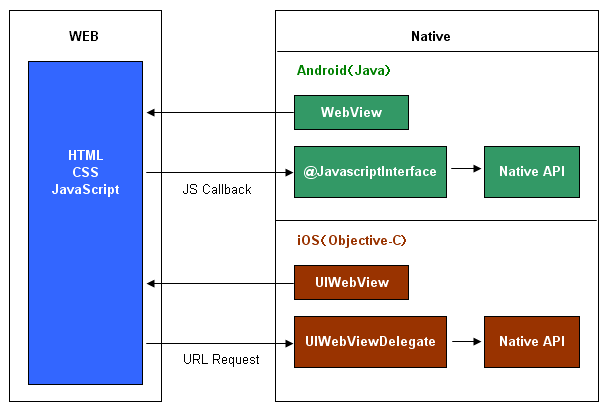Cordova 应用基于 Webview,所以后台代码和 js 交互都是基于 Webview(Webkit)的接口的。
Android:WebView(WebKit-based) WebView(4.4 Chromium-based) Updatable-WebViews(5+) @JavascriptInterface/WebView#addJavascriptInterface()
参考源码 ExposedJsApi.java
iOS:UIWebView(iOS 4+) WKWebView(iOS 8.1+) UIWebViewDelegate/UIWebView#stringByEvaluatingJavaScriptFromString()
参考源码 CDVWebViewDelegate.m

以下以 Android 调用照相机为例,简单说明一下调用及回调过程。
(1)创建的过程
①添加插件
引用
cordova plugin add org.apache.cordova.camera在 plugins 的目录下创建 org.apache.cordova.camera 文件夹,并将该 Plugin 的所有代码 Copy 进去,具体代码依赖关系都记录在 plugin.xml 里。
②创建 Android 工程
引用
cordova platform add android
从上边的 Plugin 文件夹中把 Java 文件和 js 文件 Copy 到 Android 工程的相应的文件夹下。
其中 CameraLauncher 扩展自 CordovaPlugin,而 CordovaPlugin 定义在 platforms\android\CordovaLib 中,它是 Cordova 的基础框架代码。
(2)调用的过程(JS->Native)
①HTML 中引入 cordova.js
引用
<script type="text/javascript" src="cordova.js"></script>先做初始化处理,后根据 cordova_plugins.js 加载所有 plugin 的 js 文件。
②在 deviceready 事件中调用 Camera
Js 代码
navigator.camera.getPicture(onSuccess, onFail,
{ quality: 50,
allowEdit: true,
destinationType: destinationType.DATA_URL });
③调用 Camera.js 的 getPicture 方法
assets\www\plugins\org.apache.cordova.camera\www\Camera.js getPicture() -> exec(successCallback, errorCallback, "Camera", "takePicture", args) -> function androidExec(success, fail, service, action, args) ***cordova.js -> var messages = nativeApiProvider.get().exec(service, action, callbackId, argsJson);④调入 Java 的 exec()方法
在 CordovaWebView 初期化的时候会根据 Android 的版本,将 ExposedJsApi 对象添加到 CordovaWebView 中。 this.addJavascriptInterface(exposedJsApi, "_cordovaNative");
所以 nativeApiProvider.get()的时候会根据 _cordovaNative 对象是否存在来判断是使用JavascriptInterface 方式,还是使用 prompt 方式。
如果使用 JavascriptInterface 方式(Android 4.2以上版本),直接进入 ExposedJsApi.java 中定义了@JavascriptInterface 标示的 exec()方法 。
如果使用 prompt 方式,CordovaChromeClient.java 中重写了 onJsPrompt()方法,来调用 exposedJsApi.exec()。
prompt(argsJson, 'gap:'+JSON.stringify([service, action, callbackId]));
总之入口都是 exposedJsApi.exec().
@JavascriptInterface
public String exec(String service, String action, String callbackId, String arguments) -> pluginManager.exec(service, action, callbackId, arguments);PluginManager 根据 service 调用获取到相应的 CordovaPlugin
-> CameraLauncher.execute(String action, JSONArray args, CallbackContext callbackContext)CameraLauncher 根据 action,这里是“takePicture”做本地 API 调用。
->
takePicture()
->
new Intent("android.media.action.IMAGE_CAPTURE");
cordova.startActivityForResult()
调用 CordovaInterface(CordovaActivity->Activity)的 startActivityForResult
(3)回调的过程(Native->JS)
①上述 API 调用成功后,在 onActivityResult(CameraLauncher.java)设置结果
onActivityResult(int requestCode, int resultCode, Intent intent)
// Send Uri back to JavaScript for viewing image this.callbackContext.success(uri.toString());
②退回到 ExposedJsApi 的 exec()方法
jsMessageQueue.setPaused(false);
->
NativeToJsMessageQueue的onNativeToJsMessageAvailable()
->
sendMessageMethod = webViewCore.getClass().getDeclaredMethod("sendMessage", Message.class)
->
sendMessageMethod.invoke(webViewCore, execJsMessage)
③cordova.js 中接收消息
androidExec.processMessages(messages) -> processMessage(message) -> cordova.callbackFromNative(callbackId, success, status, [payload], keepCallback);调用定义好的成功或者失败的 JS 回调函数。(payload 为回传值)
邮箱 626512443@qq.com
电话 18611320371(微信)
QQ群 235681453
Copyright © 2015-2024
备案号:京ICP备15003423号-3